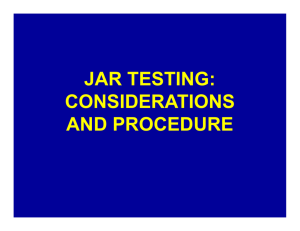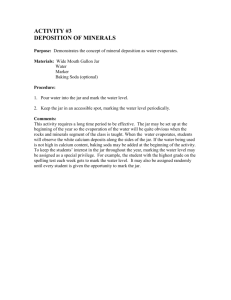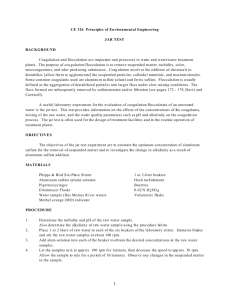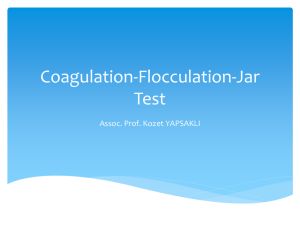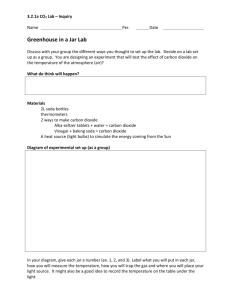ENGINEERING SCIENCE DEPARTMENT Name Water and
advertisement
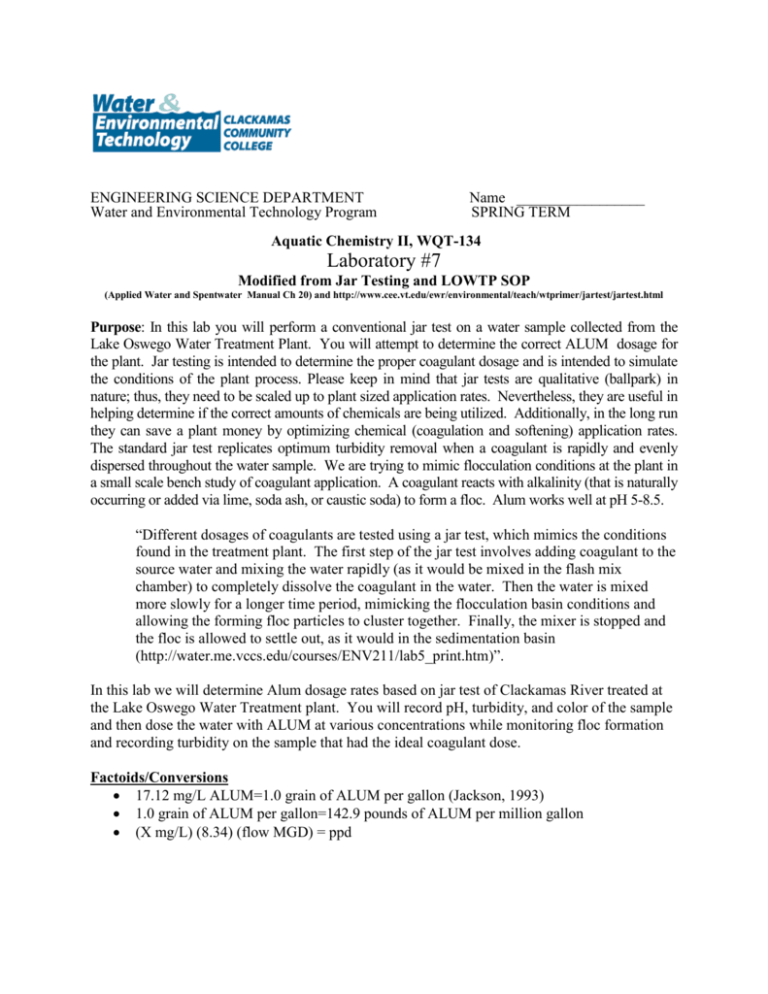
ENGINEERING SCIENCE DEPARTMENT Water and Environmental Technology Program Name _________________ SPRING TERM Aquatic Chemistry II, WQT-134 Laboratory #7 Modified from Jar Testing and LOWTP SOP (Applied Water and Spentwater Manual Ch 20) and http://www.cee.vt.edu/ewr/environmental/teach/wtprimer/jartest/jartest.html Purpose: In this lab you will perform a conventional jar test on a water sample collected from the Lake Oswego Water Treatment Plant. You will attempt to determine the correct ALUM dosage for the plant. Jar testing is intended to determine the proper coagulant dosage and is intended to simulate the conditions of the plant process. Please keep in mind that jar tests are qualitative (ballpark) in nature; thus, they need to be scaled up to plant sized application rates. Nevertheless, they are useful in helping determine if the correct amounts of chemicals are being utilized. Additionally, in the long run they can save a plant money by optimizing chemical (coagulation and softening) application rates. The standard jar test replicates optimum turbidity removal when a coagulant is rapidly and evenly dispersed throughout the water sample. We are trying to mimic flocculation conditions at the plant in a small scale bench study of coagulant application. A coagulant reacts with alkalinity (that is naturally occurring or added via lime, soda ash, or caustic soda) to form a floc. Alum works well at pH 5-8.5. “Different dosages of coagulants are tested using a jar test, which mimics the conditions found in the treatment plant. The first step of the jar test involves adding coagulant to the source water and mixing the water rapidly (as it would be mixed in the flash mix chamber) to completely dissolve the coagulant in the water. Then the water is mixed more slowly for a longer time period, mimicking the flocculation basin conditions and allowing the forming floc particles to cluster together. Finally, the mixer is stopped and the floc is allowed to settle out, as it would in the sedimentation basin (http://water.me.vccs.edu/courses/ENV211/lab5_print.htm)”. In this lab we will determine Alum dosage rates based on jar test of Clackamas River treated at the Lake Oswego Water Treatment plant. You will record pH, turbidity, and color of the sample and then dose the water with ALUM at various concentrations while monitoring floc formation and recording turbidity on the sample that had the ideal coagulant dose. Factoids/Conversions 17.12 mg/L ALUM=1.0 grain of ALUM per gallon (Jackson, 1993) 1.0 grain of ALUM per gallon=142.9 pounds of ALUM per million gallon (X mg/L) (8.34) (flow MGD) = ppd Advantages Measurement range of the turbidimeter shall be 0 to 10,000 NTU with automatic ranging and decimal point placement. Accuracy shall be ± 2% of reading or ± 0.005 NTU below 1000 NTU or ± 5% of reading from 1000 to 4000 NTU. Accuracy between 4000 and 10000 NTU shall be ± 10%. Stray light must be < 0.02 NTU. Good floc appears heavy and tight, not to dense with spaces of bright water between the particles and will begin to settle as soon as the stirrer is turned off Disadvantages/Interferences Proper stir rate difficult to obtain with a stir plate If water has minimal turbidity flocs can be hard to see Coagulant underfeed rate will cause the sample to appear cloudy with little or no floc and almost no settling Coagulant overfeed rate will form dense floc that will not settle SUPPLIES/SAFTEY Please wear lab coats, safety goggles, and gloves at all times for this lab procedure. REAGENTS/STORAGE: Standard Aluminum Sulfate solution (Al2(SO4)3 ⋅18 H2O) (1 ml of solution = 10 mg as Aluminum Sulfate): In a volumetric flask prepare one liter of solution by dissolving 18.9 g of aluminum with 18 moles of water in 800 ml of distilled water. Once dissolution has taken place, dilute to exactly one liter. 1 ml of solution = 10 mg as Aluminum Sulfate: Standard Aluminum Sulfate solution from LOWTP To make a stock solution, add 6.2 ml fresh liquid Alum to 993.8 ml DI H2O. One ml of solution contains 4 mg of concentrate: when added to 1 L of sample, the dosage is 1 mg/L (ppm). Lab Materials: Hach DR 800 colorimeter (method 8025 color and method 8237 turbidity) Turbidimeter Hach 2100A with standards Timer, 0.02 micron filter discs and syringes (6) 1000 ml Phipps and Bird Floc beakers for Flocculator Students need (6) 1000 ml beakers per student with Three stir bars (small, medium, and large) and three stir plates per student Analytical balance Pipets (1 mL) A stirring machine with six paddles capable of variable speeds from 0 to 100 revolutions per minute (RPM). Phipps and Bird Floc illuminator All pH meters and probes SUMMARY PROCEDURE Modified from Jar testing (Applied Water and Spentwater Manual Ch 20) Hardness Measurement: Basically we are going to add ALUM at different application rates and stir it at different speeds to determine ideal coagulant dosage rates for our unknown sample. Step-by-step Procedure Modified from LOWTP SOP and (Applied Water and Spentwater Manual Ch 20) Part 1 Determine COLOR, TRUE AND APPARENT (0 to 500 units) Hach DR 800 Colorimeter Color may be expressed as “apparent” or “true” color. The apparent color includes color from dissolved materials plus that from suspended matter. By filtering or centrifuging out the suspended materials, the true color can be determined. The procedure describes true color analysis. If apparent color is desired, it can be determined by measuring an unfiltered water sample. The stored program is used for both forms of color. 1. Assemble the filtering apparatus (syringe and filter). Note: To test for apparent color, do not filter; begin at Step 4 and skip Step 7. 2. Rinse the filter by pouring about 50 mL of deionized water through the syringe filter. Discard the rinse water. 3. Pour about another 50 mL of deionized water through the filter. Keep this for Step 4. 4. Fill a sample cell (the blank) with 25 mL of filtered deionized water. Discard the excess. Note: For apparent color use unfiltered deionized water. 5. Enter the stored program number for APHA color. Press: PRGM The display will show: PRGM ? 6. Press: 19 ENTER The display will show PtCo and the ZERO icon. 7. Pour about 50 mL of sample through the filter. 8. Fill a second sample cell (the prepared sample) with 25 mL of the filtered sample. 9. Place the blank into the cell holder. Tightly cover the sample cell with the instrument cap. 10. Press: ZERO The cursor will move to the right, then the display will show: 0 mg/L Pt Co 11. Place the prepared sample into the cell holder. Tightly cover the sample cell with the instrument cap. 12. Press: READ The cursor will move to the right, then the result in Platinum-Cobalt color units (Pt-Co) will be displayed. Record True and Apparent Colors for the Lake O water plant sample and your own unknown sample in the data sheet provided . 13. For apparent color use unfiltered water and complete steps 5-12. Complete these steps for Lake Oswego Water treatment plant and your own water sample. Part 2 Turbidity 595 Method 8237 TURBIDITY (0 to 1000 FAU) For water, wastewater, and seawater Absorptometric Method* * Adapted from FWPCA Methods for Chemical Analysis of Water and Wastes, 275 (1969) 1. Enter the stored program number for turbidity. Press: PRGM The display will show: PRGM ? Note: 1 FAU=1 NTU=1 FTU when measuring formazin. These are not equivalent when measuring other types of standards or samples. 2. Press: 95 ENTER The display will show FAU and the ZERO icon. 3. Fill a sample cell with 10 mL of deionized water (the blank). Note: Wipe the surface of the cell with a soft cloth. Note: For highly colored samples, use a filtered portion of sample in place of the deionized water. 4. Place the blank into the cell holder. Tightly cover the sample cell with the instrument cap. 5. Press: ZERO The cursor will move to the right, then the display will show: 0 FAU 6. Fill another sample cell with 10 mL of sample. Note: Mix the sample well before transferring it to the sample cell. Note: Wipe the surface of the cell with a soft cloth. 7. Place the sample cell into the cell holder. Tightly cover the sample cell with the instrument cap. 8. Press: READ The cursor will move to the right, then the result in Formazin Attenuation Units (FAU) will be displayed. 9. Record the FAU reading on your unknown sample and post coagulated water. Convert to NTU. Part 1 IN CLASS DEMONSTATION COAGULANT DOSE (Chapter 20) The jar test procedures involves the following steps: 1. Record the pH ___________ , turbidity __________ and color ___________ of the LOWTP water treatment plant sample. 2. Fill the Phipps and Bird jar testing apparatus containers with 1000 ml of sample water. 3. Label each Beaker #1 add 1 liter of water =control, Beaker #2 add 2 ml of alum=2 mg/L, Beaker #3 add 5 ml of alum=5 mg/L, Beaker #4 add 10 ml of alum=10 mg/L, Beaker #5 add 15 ml of alum=15 mg/L, Beaker #6 add 20 ml of alum=20 mg/L 4. Add the coagulant to each container and stir at approximately 100 rpm for 1 minute (record condition of flocs during rapid mix coagulation). The rapid mix stage helps to disperse the coagulant throughout each container. Coagulants are chemical additions, such as metallic salts, which help cause smaller aggregates to form larger particles. 5. Reduce the stirring speed to 25 to 35 rpm and continue mixing for 15 to 20 minutes(record condition of flocs every 5 minutes on data sheet below). This slower mixing speed helps promote floc formation by enhancing particle collisions which lead to larger flocs. These speeds are slow enough to prevent sheering of the floc due to turbulence caused by stirring to fast. 6. Determine which coagulant dosage has the best flocculation time and the most floc settled out. This is the optimal coagulant dosage. A hazy sample indicates poor coagulation. Properly coagulated water contains floc particles that are well-formed and dense, with the liquid between the particles clear. 7. Test the turbidity of the water in each beaker using a turbidimeter (record value on data sheet). Pipet water out of the top of the first beaker and place it in a sample tube, making sure that no air bubbles are present in the sample. (Air bubbles will rinse while turbidity will sink.) Carefully wipe the outside of the sample tube clean. Place the sample tube in a calibrated turbidimeter and read the turbidity. Repeat for the water from the other beakers. The least turbid sample should correspond to the optimal coagulant dosage chosen in step 15. Part 2 LOWTP “Team” CLASS COAGULANT DOSE (Chapter 20) The jar test procedures involves the following steps: 8. Record the pH ___________ , turbidity __________ and color ___________ of the LOWTP water treatment plant sample. 9. Fill the 6, 1 L beakers with sample water. 10. Label each beaker #1 add 1 liter of water =control, Beaker #2 add _____ ml of alum= ___ mg/L, Beaker #3 add ____ ml of alum=______ mg/L, Beaker #4 add _____ml of alum=______ mg/L, Beaker #5 add _____ ml of alum=______ mg/L, Beaker #6 add ______ ml of alum=_________ mg/L 11. Add the coagulant to each container and stir at approximately 100 rpm for 1 minute (record condition of flocs during rapid mix coagulation). The rapid mix stage helps to disperse the coagulant throughout each container. Coagulants are chemical additions, such as metallic salts, which help cause smaller aggregates to form larger particles. 12. Reduce the stirring speed to 25 to 35 rpm and continue mixing for 15 to 20 minutes(record condition of flocs every 5 minutes on data sheet below). This slower mixing speed helps promote floc formation by enhancing particle collisions which lead to larger flocs. These speeds are slow enough to prevent sheering of the floc due to turbulence caused by stirring to fast. 13. Determine which coagulant dosage has the best flocculation time and the most floc settled out. This is the optimal coagulant dosage. A hazy sample indicates poor coagulation. Properly coagulated water contains floc particles that are well-formed and dense, with the liquid between the particles clear. 14. Test the turbidity of the water in each beaker using a turbidimeter (record value on data sheet). Pipet water out of the top of the first beaker and place it in a sample tube, making sure that no air bubbles are present in the sample. (Air bubbles will rinse while turbidity will sink.) Carefully wipe the outside of the sample tube clean. Place the sample tube in a calibrated turbidimeter and read the turbidity. Repeat for the water from the other beakers. The least turbid sample should correspond to the optimal coagulant dosage chosen in step 14. Ideally if lime or a coagulant aid is fed at your plant in addition to the primary coagulant, you should repeat the jar test to determine the optimum dosage of lime or coagulant aid. Use the concentration of coagulant chosen in steps 10 and 11 and alter the dosage of lime or coagulant aid (note: on account of time we will not do this). Results: 1. 2. 3. 4. A coagulant underfeed will cause the sample to appear cloudy, with little or no floc and almost no settling. A coagulant overfeed will form dense floc, however, it will appear fragile and fluffy; when the stirrer is turned off, it will not settle well. Floc formed by an overfeed is false floc which is very light and will carry over to the filters. A good floc will appear heavy and tight, not too dense with spaces of bright water between the particles and will begin to settle as soon as the stirrer is turned off. Pick the best jar and adjust the dosage of the alum feed accordingly. Jar Test Data Sheet Water Source:_____________________________________________________ Date: Time: Coagulant Type: Current Dosage: Fast Stir Time: Fast Stir Speed: Slow Stir Time: Slow Stir Speed: LO Sample Your Sample True Color Apparent Color Jar Test Dosages Jar 1 Jar 2 Jar 3 Jar 4 Jar 5 Jar 6 Volume of Raw Water (mL) Coagulant Dose (mg/L) Appearance of Floc in Jars During Fast Stir Jar 1 Appearance Jar 2 Jar 3 Jar 4 Jar 5 Jar 6 Appearance of Floc in Jars During Slow Stir Time Jar 1 After Chemical Addition Jar 2 Jar 3 Jar 4 Jar 5 Jar 6 5 Minutes 10 Minutes 15 Minutes 20 Minutes 25 Minutes 30 Minutes Appearance of Floc in Jars During Settling Time Jar 1 After Stirring Ends Jar 2 Jar 3 Jar 4 Jar 5 Jar 6 Jar 5 Jar 6 15 Minutes 30 Minutes Turbidity After Settling Jar 1 Turbidity (NTU) Jar 2 Jar 3 Jar 4
